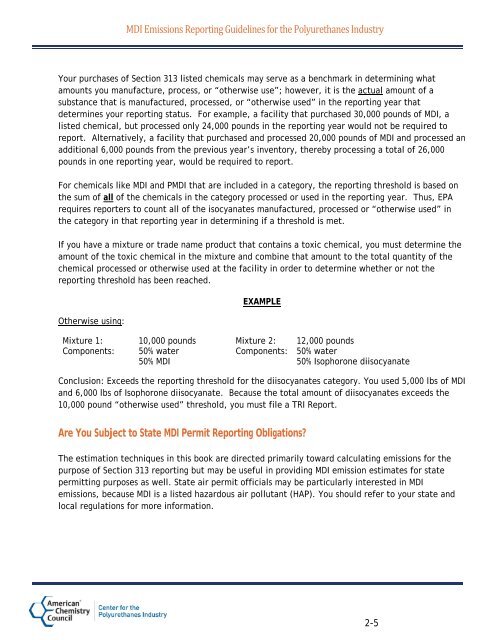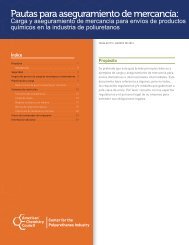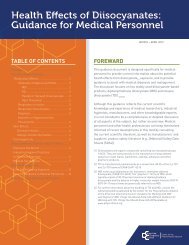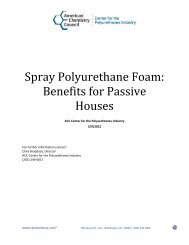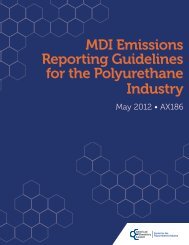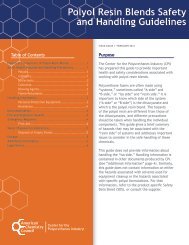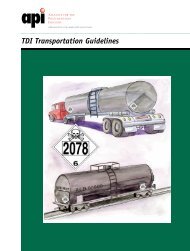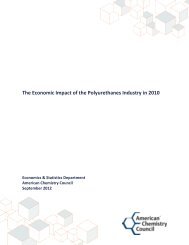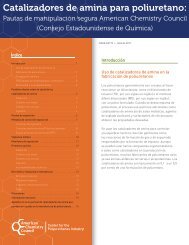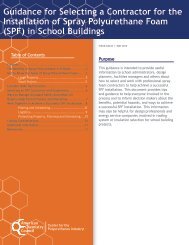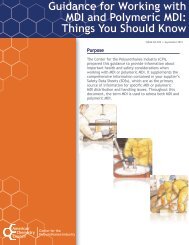MDI Emissions Reporting Guidelines for the ... - Polyurethanes
MDI Emissions Reporting Guidelines for the ... - Polyurethanes
MDI Emissions Reporting Guidelines for the ... - Polyurethanes
Create successful ePaper yourself
Turn your PDF publications into a flip-book with our unique Google optimized e-Paper software.
<strong>MDI</strong> <strong>Emissions</strong> <strong>Reporting</strong> <strong>Guidelines</strong> <strong>for</strong> <strong>the</strong> <strong>Polyurethanes</strong> Industry<br />
Your purchases of Section 313 listed chemicals may serve as a benchmark in determining what<br />
amounts you manufacture, process, or “o<strong>the</strong>rwise use”; however, it is <strong>the</strong> actual amount of a<br />
substance that is manufactured, processed, or “o<strong>the</strong>rwise used” in <strong>the</strong> reporting year that<br />
determines your reporting status. For example, a facility that purchased 30,000 pounds of <strong>MDI</strong>, a<br />
listed chemical, but processed only 24,000 pounds in <strong>the</strong> reporting year would not be required to<br />
report. Alternatively, a facility that purchased and processed 20,000 pounds of <strong>MDI</strong> and processed an<br />
additional 6,000 pounds from <strong>the</strong> previous year’s inventory, <strong>the</strong>reby processing a total of 26,000<br />
pounds in one reporting year, would be required to report.<br />
For chemicals like <strong>MDI</strong> and P<strong>MDI</strong> that are included in a category, <strong>the</strong> reporting threshold is based on<br />
<strong>the</strong> sum of all of <strong>the</strong> chemicals in <strong>the</strong> category processed or used in <strong>the</strong> reporting year. Thus, EPA<br />
requires reporters to count all of <strong>the</strong> isocyanates manufactured, processed or “o<strong>the</strong>rwise used” in<br />
<strong>the</strong> category in that reporting year in determining if a threshold is met.<br />
If you have a mixture or trade name product that contains a toxic chemical, you must determine <strong>the</strong><br />
amount of <strong>the</strong> toxic chemical in <strong>the</strong> mixture and combine that amount to <strong>the</strong> total quantity of <strong>the</strong><br />
chemical processed or o<strong>the</strong>rwise used at <strong>the</strong> facility in order to determine whe<strong>the</strong>r or not <strong>the</strong><br />
reporting threshold has been reached.<br />
O<strong>the</strong>rwise using:<br />
EXAMPLE<br />
Mixture 1: 10,000 pounds Mixture 2: 12,000 pounds<br />
Components: 50% water Components: 50% water<br />
50% <strong>MDI</strong> 50% Isophorone diisocyanate<br />
Conclusion: Exceeds <strong>the</strong> reporting threshold <strong>for</strong> <strong>the</strong> diisocyanates category. You used 5,000 lbs of <strong>MDI</strong><br />
and 6,000 lbs of Isophorone diisocyanate. Because <strong>the</strong> total amount of diisocyanates exceeds <strong>the</strong><br />
10,000 pound “o<strong>the</strong>rwise used” threshold, you must file a TRI Report.<br />
Are You Subject to State <strong>MDI</strong> Permit <strong>Reporting</strong> Obligations?<br />
The estimation techniques in this book are directed primarily toward calculating emissions <strong>for</strong> <strong>the</strong><br />
purpose of Section 313 reporting but may be useful in providing <strong>MDI</strong> emission estimates <strong>for</strong> state<br />
permitting purposes as well. State air permit officials may be particularly interested in <strong>MDI</strong><br />
emissions, because <strong>MDI</strong> is a listed hazardous air pollutant (HAP). You should refer to your state and<br />
local regulations <strong>for</strong> more in<strong>for</strong>mation.<br />
2-5


